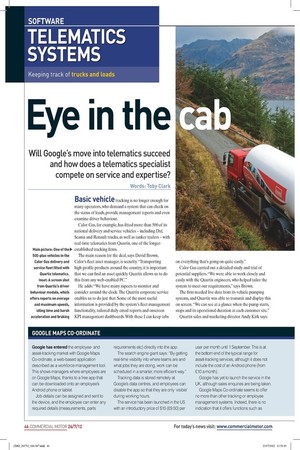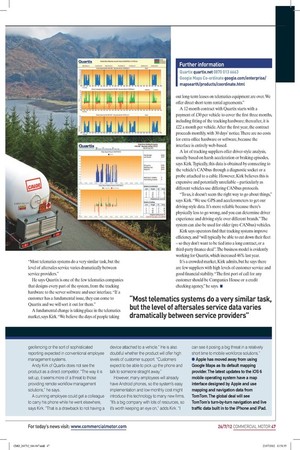Eye in the cab
Page 36

Page 37

If you've noticed an error in this article please click here to report it so we can fix it.
Will Google’s move into telematics succeed and how does a telematics specialist compete on service and expertise?
Words: Toby Clark Basic vehicle tracking is no longer enough for many operators, who demand a system that can check on the status of loads, provide management reports and even examine driver behaviour.
Calor Gas, for example, has itted more than 500 of its national delivery and service vehicles – including Daf, Scania and Renault trucks, as well as tanker trailers – with real-time telematics from Quartix, one of the longerestablished tracking irms.
The main reason for the deal, says David Brown, Calor’s leet asset manager, is security. “Transporting high-proile products around the country, it is important that we can ind an asset quickly. Quartix allows us to do this from any web-enabled PC.” He adds: “We have many aspects to monitor and consider around the clock. The Quartix corporate service enables us to do just that. Some of the most useful information is provided by the system’s leet management functionality, tailored daily email reports and onscreen KPI management dashboards. With these I can keep tabs on everything that’s going on quite easily.” Calor Gas carried out a detailed study and trial of potential suppliers. “We were able to work closely and easily with the Quartix engineers, who helped tailor the system to meet our requirements,” says Brown.
The irm needed live data from its vehicle pumping systems, and Quartix was able to transmit and display this on screen. “We can see at a glance when the pump starts, stops and its operational duration at each customer site.” Quartix sales and marketing director Andy Kirk says: “Most telematics systems do a very similar task, but the level of aftersales service varies dramatically between service providers.” He says Quartix is one of the few telematics companies that designs every part of the system, from the tracking hardware to the server software and user interface. “If a customer has a fundamental issue, they can come to Quartix and we will sort it out for them.” A fundamental change is taking place in the telematics market, says Kirk. “We believe the days of people taking out long-term leases on telematics equipment are over. We offer direct short-term rental agreements.” A 12-month contract with Quartix starts with a payment of £30 per vehicle to cover the irst three months, including itting of the tracking hardware; thereafter, it is £22 a month per vehicle. After the irst year, the contract proceeds monthly, with 30 days’ notice. There are no costs for extra ofice hardware or software, because the interface is entirely web-based.
A lot of tracking suppliers offer driver-style analysis, usually based on harsh acceleration or braking episodes, says Kirk. Typically, this data is obtained by connecting to the vehicle’s CANbus through a diagnostic socket or a probe attached to a cable. However, Kirk believes this is expensive and potentially unreliable – particularly as different vehicles use differing CANbus protocols.
“To us, it doesn’t seem the right way to go about things,” says Kirk. “We use GPS and accelerometers to get our driving-style data. It’s more reliable because there’s physically less to go wrong, and you can determine driver experience and driving style over different brands.” The system can also be used for older (pre-CANbus) vehicles.
Kirk says operators ind that tracking systems improve eficiency, and “will typically be able to cut down their leet – so they don’t want to be tied into a long contract, or a third-party inance deal”. The business model is evidently working for Quartix, which increased 46% last year.
It’s a crowded market, Kirk admits, but he says there are few suppliers with high levels of customer service and good inancial stability. “The irst port of call for any customer should be Companies House or a credit checking agency,” he says. ■
GOOGLE MAPS CO-ORDINATE
Google has entered the employeeand asset-tracking market with Google Maps Co-ordinate, a web-based application described as a workforce management tool. This shows managers where employees are on Google Maps, thanks to a free app that can be downloaded onto an employee’s Android phone or tablet.
Job details can be assigned and sent to the device, and the employee can enter any required details (measurements, parts requirements etc) directly into the app.
The search engine giant says: “By getting real-time visibility into where teams are and what jobs they are doing, work can be scheduled in a smarter, more efficient way.” Tracking data is stored remotely at Google’s data centres, and employees can disable the app so that they are only ‘visible’ during working hours.
The service has been launched in the US with an introductory price of $15 (£9.50) per user per month until 1 September. This is at the bottom end of the typical range for asset-tracking services, although it does not include the cost of an Android phone (from £10 a month).
Google has yet to launch the service in the UK, although sales enquiries are being taken.
Google Maps Co-ordinate seems to offer no more than other tracking or employee management systems. Indeed, there is no indication that it offers functions such as geofencing or the sort of sophisticated reporting expected in conventional employee management systems.
Andy Kirk of Quartix does not see the product as a direct competitor. “The way it is set up, it seems more of a threat to those providing remote workflow management solutions,” he says.
A cunning employee could get a colleague to carry his phone while he went elsewhere, says Kirk. “That is a drawback to not having a device attached to a vehicle.” He is also doubtful whether the product will offer high levels of customer support. “Customers expect to be able to pick up the phone and talk to someone straight away.” However, many employees will already have Android phones, so the system’s easy implementation and low monthly cost might introduce this technology to many new firms. “It’s a big company with lots of resources, so it’s worth keeping an eye on,” adds Kirk. “I
can see it posing a big threat in a relatively short time to mobile workforce solutions.” l Apple has moved away from using Google Maps as its default mapping provider. The latest updates to the iOS 6 mobile operating system have a map interface designed by Apple and use mapping and navigation data from TomTom. The global deal will see TomTom’s turn-by-turn navigation and live traffic data built in to the iPhone and iPad.









































